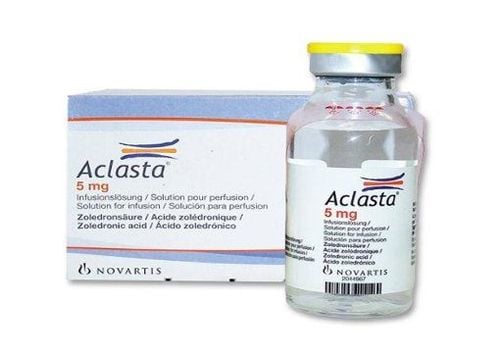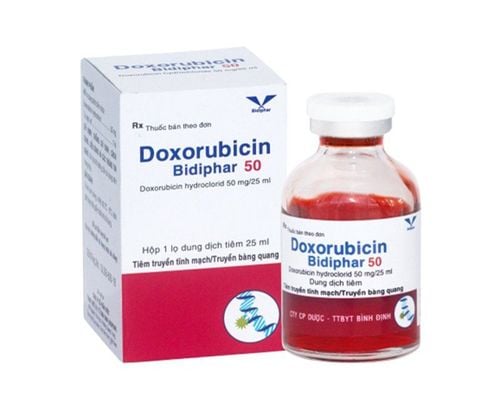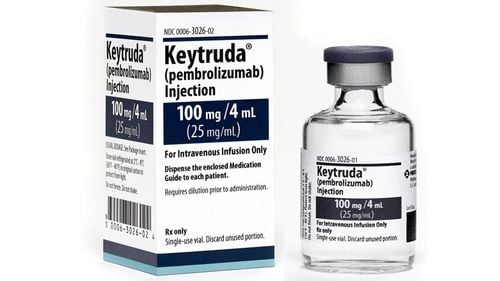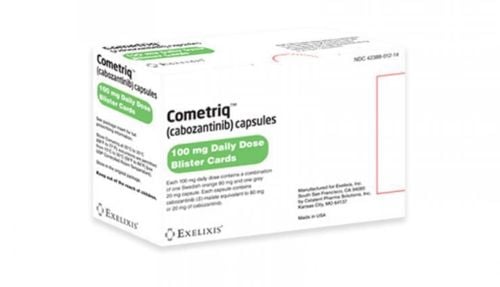This is an automatically translated article.
Zoledronic acid is an active bisphosphonate, indicated for the purpose of preventing bone damage or treating hypercalcemia in cancer patients. This active ingredient is present in the drug Zoltasta 4mg/5ml. So what should patients pay attention to when taking Zoltasta?1. Indications and contraindications of Zoltasta 4mg/5mg
The main ingredient in Zoltasta is Zoledronic Acid. Zoltasta is indicated in the following cases:Prevention of bone-related phenomena, including pathological fractures, radiation therapy or bone surgery, spinal compression, hypercalcemia... in cancer patients advanced cancer, which includes bone cancer; Treatment of hypercalcemia due to cancer pathology. The use of Zoltasta 4mg is contraindicated in the following cases:
Patients who are allergic to Zoledronic acid or any of its ingredients; Pregnant and lactating patients should not take Zoltasta ; Concomitant use of Zoltasta 4mg with other bisphosphonates is contraindicated.
2. Dosage of Zoltasta
Prevention of bone-related conditions in patients with advanced cancer:
Adults and the elderly: The recommended dose is 4mg Zoledronic Acid in a reconstituted solution, then further diluted for intravenous infusion. (dilute with 100ml of 0.9% NaCl or 5% glucose solution) for at least 15 minutes each time, every 3-4 weeks as an infusion. At the same time, patients need to be supplemented with 500mg of Calcium and 400IU of vitamin D per day; Treatment of hypercalcemia due to cancer:
Adults and the elderly: The recommended dose is 4mg of Zoledronic Acid in a reconstituted solution and further diluted for intravenous infusion over a minimum of 15 minutes, possibly repeat after 7 days; Note to fully rehydrate the patient before and during treatment with Zoltasta 4mg.
3. Zoltasta side effects
Some common side effects of Zoltasta include:
Zoledronic acid can cause anemia, decreased platelet and white blood cell counts; Headache, dizziness; Taste disorder; Conjunctivitis ; Nausea, vomiting with loss of appetite; Bone pain, muscle pain or body aches. Some less common side effects of Zoltasta:
Decrease in the total number of blood cells; Anxiety or sleep disturbances; Cardiac arrhythmias; Hypomagnesemia and hypokalemia.
4. Drug interactions of Zoltasta 4mg/5ml
To avoid incompatibilities, the reconstituted solution of Zoltasta should be further diluted with an isotonic solution such as 0.9% NaCl or 5% Glucose.
Reconstituted Zoltasta 4mg/5ml solution should not be mixed with infusion solutions containing calcium or divalent cations (such as Ringer's lactate solution) and Zoltasta must be infused by a separate infusion line not with other drugs.
5. Be careful when using Zoltasta
The doctor needs to evaluate and examine the patient thoroughly before deciding to use Zoltasta to make sure the patient is sufficiently hydrated. However, limit excessive fluid intake for patients at risk of heart failure. Physicians should carefully monitor standard metabolic parameters associated with hypercalcaemia, such as measurement of serum calcium, phosphate and magnesium concentrations after initiation of therapy. If hypocalcaemia, hypophosphataemia, or hypomagnesemia occur, the patient may require short-term additional therapy. It is common for patients with untreated hypercalcaemia to have some degree of renal impairment, therefore close monitoring of renal function should be considered when taking Zoltasta 4mg. Patients should not take more than one medicine containing the same active ingredient Zoledronic Acid at the same time. To date, the safety and efficacy of Zoltasta in pediatric patients have not been established. Patients with laboratory evidence of impaired renal function should be carefully evaluated and considered whether the benefits of treatment with Zoltasta outweigh the potential risks. The decision to treat patients with metastatic bone cancer should be considered in order to prevent skeletal-related events because the therapeutic effect begins only after 2-3 months. Zoltasta 4mg may cause renal dysfunction. Factors that may increase the risk of kidney damage include dehydration, pre-existing renal failure, multiple cycles of Zoltasta or other bisphosphonates, concomitant use of nephrotoxic drugs or intravenous infusion. Zoltasta for a shorter time than prescribed. The risk of side effects is reduced by infusion of 4 mg of Zoltasta over 15 minutes, but there is still the possibility of impaired renal function. Renal damage, progression to renal failure, and hemodialysis have been reported in patients following the initial dose of Zoltasta. In some cases, there was an increase in serum creatinine when taking the drug at the recommended dose, however, when used for a long time to prevent skeletal problems, this side effect was less common than other effects. other side effects. Before each dose of Zoltasta, the patient should have a serum creatinine test. When initiating Zoltasta 4 mg in adult patients with bone metastases with mild to moderate renal impairment, a lower dose of the drug should be used. For patients with evidence of kidney damage during treatment with Zoltasta 4mg, if the creatinine level returns to within 10% of baseline, the doctor will re-introduce the drug. Because of the strong effect of bisphosphonates, including Zoltasta, on renal function, there is a lack of clinical safety data in patients with severe renal impairment. Therefore, Zoltasta is not indicated for these cases. The safety of Zoltasta 4mg in pediatric patients with renal impairment has not been established. Due to limited clinical data in patients with severe hepatic impairment, Zoltasta 4 mg is not recommended for this population.
Please dial HOTLINE for more information or register for an appointment HERE. Download MyVinmec app to make appointments faster and to manage your bookings easily.













